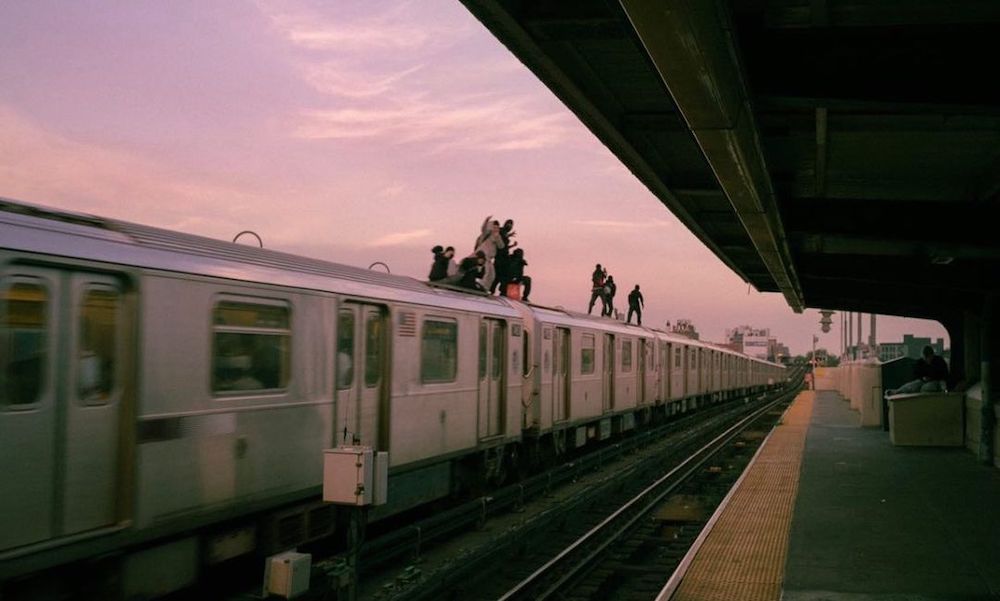NYC subway surfers 
That’s the question that elected officials and many others are asking after the recent death of yet another 15-year-old “subway surfer” in New York City. According to police, teenager Zackery Noel Nazario hit his head on something, presumably a beam, and fell beneath a Manhattan-bound J train as it crossed the Williamsburg Bridge on Monday evening. His girlfriend was reportedly with him at the time and about to climb up on top of the subway car to join him, when things went terribly wrong; she narrowly escaped injury.
The boy’s grieving mother, Norma Nazario, told broadcast news that Zackery “was a very nice kid. Old soul, very mature. Good kid, good kid.” Like many moms with subway surfer sons, she had no idea her child was engaged in such wildly dangerous activities and wonders to what extent social media influenced him to “surf.” Just a few months ago, the transit community was shaken up by the loss of Ka-Von Wooden, also 15, in a similar mishap on the same train line on the same bridge. Several surfers told ANIMAL they were absolutely quitting after his death.
Mayor Eric Adams said social media is to blame. “Some of these sites, they’re more addictive than drugs, people can’t get off them. And you start duplicating this behavior.” He’s urging elected federal officials to look into the effect social media has on fueling the fire. “I think the national government must come in and say, ‘What is the corporate responsibility of social media?’ I’m just surprised this hasn’t been done,” said the mayor.
NBC reports that subway surfing incidents have skyrocketed in recent years:
In 2022, there were 928 reports of such incidents. That’s more than double the number reported the year before (206) and in 2020 (199), though those years may have seen data impacted by the COVID-19 pandemic. Still, the 2022 figure represents a 160 percent spike from 2019 levels (ridership in November and December 2022 had roughly returned to 2019 levels).
MTA chairman Janne Lieber blamed the uptick of subway surfing squarely on social media and on Wednesday, implored companies such as Instagram, TikTok, and Twitter, to take down all videos depicting subway surfing. During a radio interview, Lieber likened the highly dangerous activity to Russian roulette. “The right thing to do is to not put up these videos, which obviously have negative consequences,” said Lieber. “If they were running videos of people playing Russian roulette with live bullets, they would understand the consequences and this is the equivalent for kids.”
For some, it’s a no-brainer. Remove the harmful content and the harmful actions will stop, right? Maybe! But where should these platforms draw the line? Every day, their algorithms serve up a buffet of New York City youth engaged in questionable antics, from dangling their legs off the ledges of skyscrapers, to jumping from girder to girder on elevated lines, to swerving bikes into buses and acts of parkour that would impress even the most seasoned stuntmen. Graffiti writers also often risk personal safety to get up in the real world and online. Should they get removal notices too? How about drivers who cut it up through traffic? Let’s not forget the maniacs who parachute off buildings? Should everything dangerous be removed from social media?
Since 2003, ANIMAL has always prided itself as being an unvarnished lens on youth culture, with all its good and bad and in-betweens. If kids in NYC are subway surfing, we’re going to show it. We are not going to plant our heads in the sand and ignore what’s going on. At the same time, we don’t want young kids dying for likes. Censorship is a question without an easily-packaged answer. Subway surfing is both exhilarating and shocking, euphoric and lethal. It’s also a true life urban phenomenon that’s taking place right before our very eyes and even making lifelong New Yorkers turn their heads. How do you just ignore that? It may also be pointing to a more underlying matter.
Is there something else, something behind the scenes that we’re missing? What is it that’s fueling not only subway surfing, but also the circus-like roster of death-defying feats being performed every day by city teens? Is it all social media or did the lockdowns and blur of the years-long pandemic inadvertently create a new breed of young daredevils hellbent on feeding off all that pent up energy and exhibiting it to the world?



